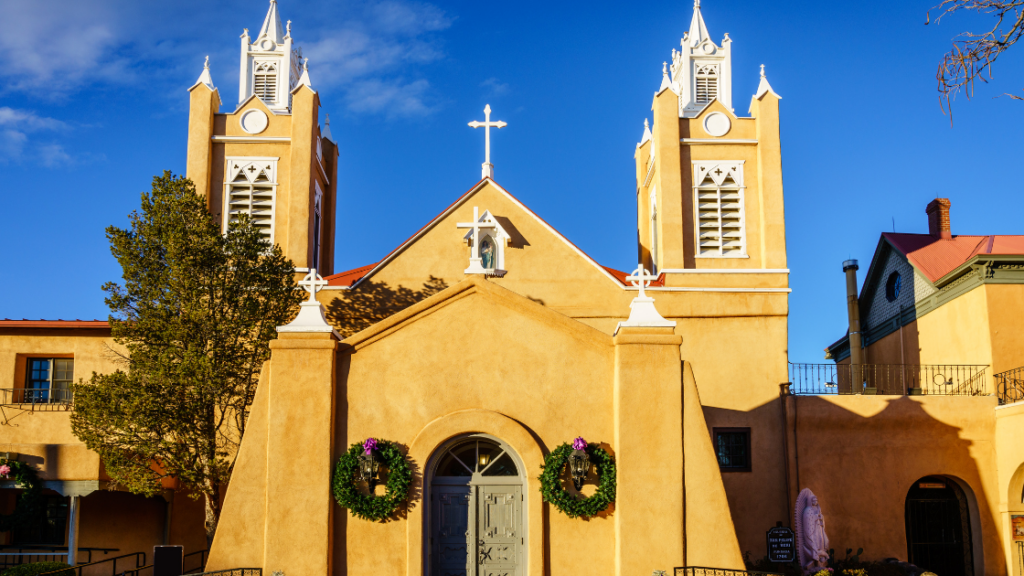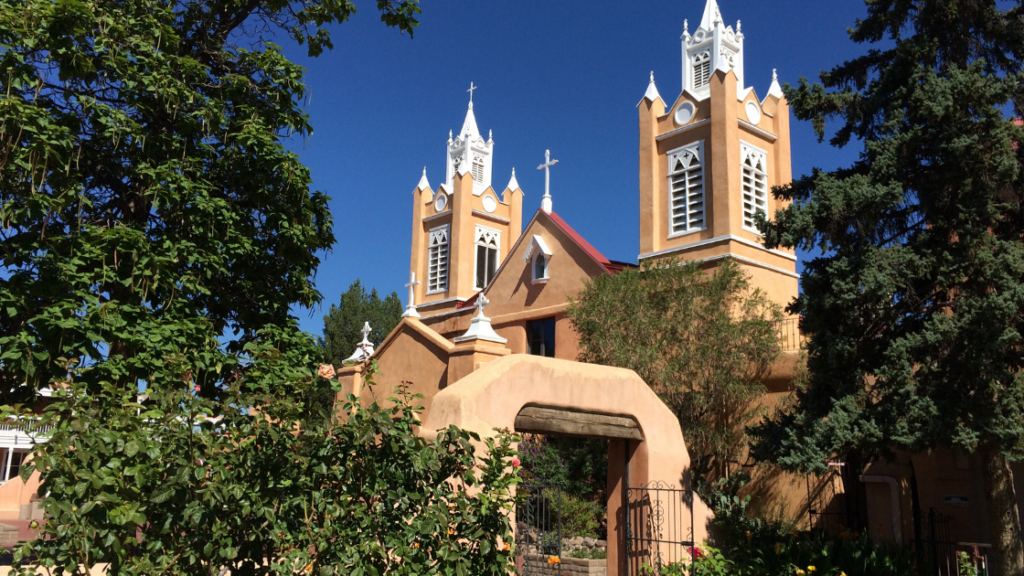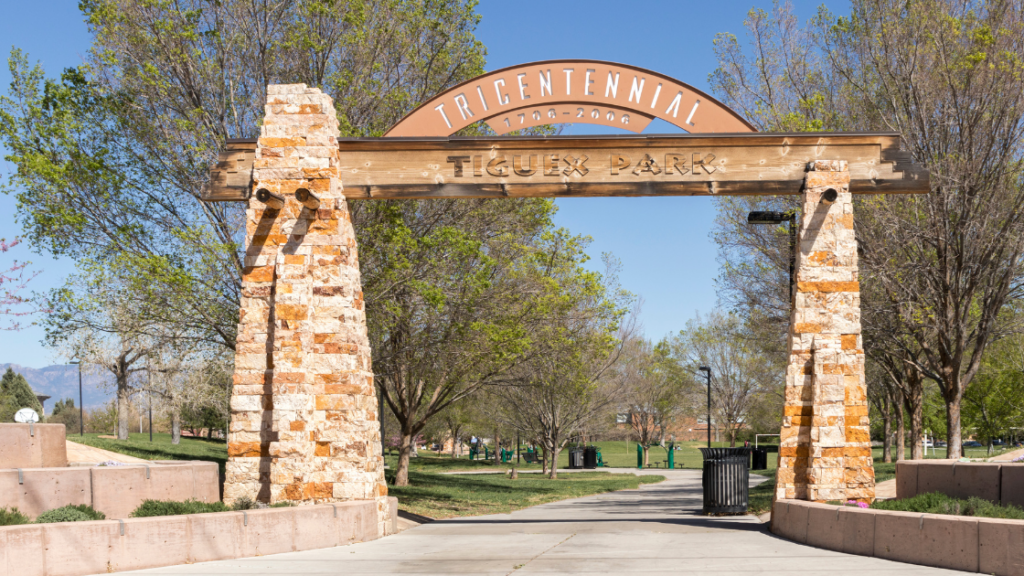San Felipe de Neri Church: The Oldest Parish in Albuquerque

Located in the heart of Old Town Plaza, San Felipe de Neri Church is a living piece of history. Rebuilt in 1793, this adobe church has stood for over 230 years as a symbol of faith, culture, and community. With its thick adobe walls, serene courtyard, and towering bell towers, it’s a must-see for history buffs and architecture lovers alike.
But what truly stands out about San Felipe de Neri? Beyond its physical beauty, it tells the story of Albuquerque’s roots, resilience, and people’s dedication.
Come explore its history, architecture, and cultural significance!
The History of San Felipe de Neri Church
Founding the Parish (1706)
San Felipe de Neri was established back in 1706 when Spanish settlers founded Albuquerque as a villa. Picture it: settlers seeking to build a center of governance and a thriving community chose to construct a church as the town’s focal point. They named it after St. Philip Neri, a cherished saint celebrated for his joyful spirit and strong ties to the community.
San Felipe de Neri wasn’t just a place for Sunday services. It became a hub for gatherings and played a huge role in shaping Albuquerque’s early culture and governance. This church wasn’t just significant for worship; it was the foundation of community life.
Rebuilding and Expansion (1793)
Fast forward to the 1790s, and disaster struck. A fire swept through the original structure, leaving the church in ashes. But the resilient people of Albuquerque wouldn’t be set back for long. By 1793, the community came together to rebuild what we see standing today—an adobe masterpiece.
The construction reflected the spirit of unity, with locals pitching in to restore their beloved church. This collaborative effort became a testament to the perseverance and devotion of the Albuquerque community.
Architectural Marvels of San Felipe de Neri
A Blend of Spanish Colonial and Pueblo Styles

If you’re a fan of architecture that tells a story, San Felipe de Neri will leave you in awe. The church boasts thick adobe walls that whisper tales of centuries gone by, high wooden beam ceilings that draw your eyes heavenward, and intricately designed bell towers that pay homage to Spanish Colonial influences.
But that’s not all. As you step inside, you’re greeted by a magnificent altar designed in the Spanish Colonial style—simple yet breathtaking. Outside, the courtyard garden, dotted with religious statues, feels like a peaceful oasis. Don’t forget to check out the intricately crafted wooden spiral staircase.
Preserving the Past
Maintaining a centuries-old adobe structure isn’t easy, but San Felipe de Neri’s caretakers have risen to the challenge.
Over the years, it’s undergone careful restoration projects to ensure it remains standing proud. That’s no small feat considering the wear and tear adobe buildings face in a modern world.
The Cultural and Religious Significance of San Felipe de Neri
A Place of Worship and Celebration
Though it’s over 300 years old, San Felipe de Neri is far from just a tourist attraction. The church continues to thrive as an active parish, offering regular services and masses.
It’s also a hub for community celebrations, including feast days for its patron saint, St. Philip Neri. Imagine the joy, the festivities, and the sense of togetherness that have filled these walls for centuries—it’s nothing short of magical.
A Historic Landmark in Old Town
San Felipe de Neri isn’t just a spiritual site; it’s a symbol of Albuquerque’s resilience and cultural heritage. Recognized on the National Register of Historic Places, it serves as a proud reminder of the city’s roots. For Albuquerque residents, it’s not just a landmark; it’s a badge of honor. For visitors, it’s a doorway to the city’s rich past.
Visiting San Felipe de Neri Church Today
What to Expect
Planning a visit? You’re in for a treat. The church is open to visitors and offers a tranquil retreat from the hustle and bustle of modern life. Be sure to explore the beautifully designed interior, the serene courtyard, and an adjacent museum filled with fascinating artifacts. Guided tours are alos available for those wanting the full historical rundown. Practical matters? San Felipe de Neri’s visiting hours are quite accommodating, with plenty of parking nearby. It’s also easily accessible, making it a stress-free stop for tourists and locals alike.
Nearby Attractions in Old Town Plaza
Once you’re satisfied soaking in the beauty of San Felipe de Neri, there’s plenty more to see and do in Old Town Plaza. Peruse local shops and galleries for one-of-a-kind finds, or take a relaxing stroll through Tiguex Park. The area is perfect for making a day out of your visit.

Reflecting on the Legacy of San Felipe de Neri
San Felipe de Neri Church isn’t just the oldest parish in Albuquerque—it’s a vibrant symbol of the city’s rich history, culture, and resilience. For over three centuries, it has been a space for faith, community, and celebration, standing tall as a bridge between the past and the present.
To truly experience the church’s living history, plan your visit during one of its significant events or religious celebrations. Whether it’s a traditional Mass, a festive gathering, or a cultural event, these moments bring the church’s legacy to life in a powerful way.
Whether you’re a history enthusiast, an architecture lover, or simply seeking a deeper connection to Albuquerque’s cultural heart, visiting San Felipe de Neri during these special occasions is an experience you won’t forget. Witness faith, community, and timeless beauty in action, and carry its enduring legacy with you. Don’t miss it!
